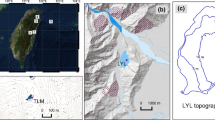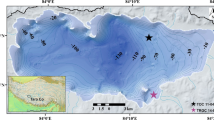Abstract
A high-resolution, multi-proxy lake sediment record was used to establish the timing of Holocene environmental change in Canoran Lake, southwest Nova Scotia, Canada. Proxies include %C, δ15N, δ13C, HI, magnetic susceptibility, and pollen. Canoran Lake is a small, shallow (11 m) lake with two ephemeral inlets and an outlet. The site was deglaciated at ca. 15,300 cal (calibrated) year BP and elevated %C values indicate the establishment of a productive aquatic environment that is consistent with Allerød warming. The Allerød was interrupted by rapid air temperature cooling during the Younger Dryas (ca. 12,900–11,600 cal year BP). The Early Hypsithermal (ca. 11,600–8,500 cal year BP) was relatively warm and wet. A slight increase in clastic input occurred between 9,100 and 8,500 cal year BP but δ15N, δ13C, and HI values imply that the lithostratigraphic response may not be indicative of climate-induced change. The strong proxy response between 8,500 and 8,000 cal year BP was likely due to cooling and drying coincident with the 8.2 k year event. The climate was relatively warm and dry during the Late Hypsithermal (ca. 8,000–3,500 cal year BP). None of the proxies’ exhibit notable change during the 5,500 cal year BP hemlock decline, indicating that ecological change was likely due to a pathogen attack. Post-Hypsithermal (modern) climate was characterized by an increase in precipitation and a decrease in air temperatures from ca. 3,500 to 700 cal year BP (top of core).





Similar content being viewed by others
References
Alley RB, Mayewski PA, Sowers T, Stuiver M, Taylor KC, Clark PU (1997) Holocene climatic instability: a prominent, widespread event 8200 years ago. Geology 25:483–486. doi:10.1130/0091-7613(1997)025<0483:HCIAPW>2.3.CO;2
Anderson TW, Levac E, Lewis CFM (2007) Cooling in the Gulf of St. Lawrence and estuary region at 9.7–7.2 14C ka (11.2–8.0 cal ka): palynological response to the PBO and 8.2 cal ka cold events, Laurentide ice sheet air mass circulation and enhanced freshwater runoff. Palaeogeogr Palaeoclimatol Palaeoecol 246:75–100. doi:10.1016/j.palaeo.2006.10.028
Barber DC, Dyke A, Hillaire-Marcel C, Jennings AS, Andrews JT, Kerwin MW, Bilodeau G, McNeely R, Southon J, Morehead MD, Gagnon JM (1999) Forcing of a cold event of 8,200 years ago by catastrophic drainage of Laurentide Lakes. Nature 400:344–348. doi:10.1038/22504
Brenner M, Whitmore TJ, Curtis JH, Hodell DA, Schelske CL (1999) Stable isotope (δ13C and δ15N) signatures of sedimented organic matter as indicators of historic lake trophic state. J Paleolimnol 22:205–221. doi:10.1023/A:1008078222806
Campbell I, McAndrews JH (1993) Forest disequilibrium caused by rapid little ice age cooling. Nature 366:336–338. doi:10.1038/366336a0
Cwynar LC, Spear RW, Vincent J, Kurek J (2003) The Preboreal oscillation in eastern North America. Joint Annual Meeting of the Canadian Quaternary Association and the Canadian Geomorphology Research Group, Halifax, Nova Scotia, 2003 June 8–12
Davis MB (1981) Outbreaks of forest pathogens in quaternary history. In: Proceedings IV International Palynological Conference, Lucknow (1976–77), 3, pp 216–227
Dean WE Jr (1974) Determination of carbonate and organic matter in calcareous sediments and sedimentary rocks by loss on ignition: comparison with other methods. J Sed Pet 44:242–248
Downing JA, Watson SB, McCauley E (2001) Predicting cyanobacteria dominance in lakes. Can J Fish Aquat Sci 58:1905–1908. doi:10.1139/cjfas-58-10-1905
Dyke AS, Prest VK (1987) Late Wisconsinan and Holocene history of the Laurentide ice sheet. Geog Phys Quat 41:237–263
Gajewski K, Vance R, Sawada M, Fung I, Gignac D, Halsey L, John J, Maisongrande P, Mandell P, Mudie PJ, Richard PJH, Sherin AG, Soroko J, Vitt DH (2000) The climate of North America and adjacent ocean waters ca. 6 ka. Can J Earth Sci 37:661–681. doi:10.1139/cjes-37-5-661
Green DG (1987) Pollen evidence for the postglacial origins of Nova Scotia’s forests. Can J Bot 65:1163–1179. doi:10.1139/b87-163
Haas JN, McAndrews JH (2000) The summer drought related hemlock (Tsuga canadensis) decline in eastern North America 5700–5100 years ago. In: Proceedings symposium on sustainable management of Hemlock Ecosystems in eastern North America, June 22–24, 1999, pp 81–88
Haas JN, Richoz I, Tinner W, Wick L (1998) Synchronous Holocene climatic oscillations recorded on the Swiss plateau and at timberline in the Alps. Holocene 8:301–309. doi:10.1191/095968398675491173
Harrison SP (1989) Lake levels and climate change in eastern North America. Clim Dyn 3:157–167. doi:10.1007/BF01080366
Hu FS, Slawinski D, Wright HE Jr, Ito E, Johnson RG, Kelts KR, McEwan RF, Boedigheimer A (1999) Abrupt changes in North American climate during early Holocene times. Nature 400:437–440. doi:10.1038/22728
Jetté H, Mott RJ (1995) Vegetation and climate of maritime Canada 6000 years BP: a synthesis. Geog Phys Quat 49:141–162
Lennox BT (2006) Post-glacial climate change and its effect on the thermal structure and habitat in a shallow dimictic lake, Nova Scotia, Canada: a chemostratigraphic and lithostratigraphic investigation. M.Sc. Thesis, Acadia University, Department of Geology, Wolfville, Nova Scotia pp 157
Levac E (2001) High resolution Holocene palynological record from the Scotian shelf. Mar Micropaleol 43:179–197. doi:10.1016/S0377-8398(01)00033-0
Martin KAM (2003) Physical evolution of Canoran Lake, Nova Scotia: Focus on lake sediment dynamics. B. Sc. Thesis, Acadia University, Environmental Science, Wolfville, Nova Scotia pp 114
Martin B (2005) A record of Holocene environmental change from the Pleasant River Fen Complex, Southwest Nova Scotia. B. Sc. Thesis, Acadia University, Environmental Science, Wolfville, Nova Scotia, pp 71
Mayle FE, Levesque AJ, Cwynar LC (1993) Accelerator-mass-spectrometer ages for the Younger Dryas in Atlantic Canada. Quat Res 39:335–360. doi:10.1006/qres.1993.1042
McCarthy FMG, Collins ES, McAndrews JH, Rerr HA, Scott DB, Medioli FS (1995) A comparison of postglacial arcellacean (‘the camoebian’) and pollen succession in Atlantic Canada, illustrating the potential of arcellaceans for paleoclimatic reconstruction. J Paleontol 69:980–993
Meyers PA, Lallier-Vergès E (1999) Lacustrine sedimentary organic matter records of late quaternary Paleoclimates. J Paleolimnol 22:345–372. doi:10.1023/A:1008073732192
Meyers PA, Teranes JL (2001) Sediment organic matter. In: Last WM, Smol JP (eds) Tracking environmental change using lake sediments Vol. 2: physical and geochemical methods. Kluwer Academic Publishers, Dordrecht, p 504
Mott RJ (1994) Wisconsinan late-glacial environmental change in Nova Scotia: a regional synthesis. J Quat Sci 9:155–160. doi:10.1002/jqs.3390090210
Mott RJ, Stea RR (1994) Late-glacial (Allerød/Younger Dryas) buried organic deposits, Nova Scotia, Canada. Quat Sci Rev 12:645–657. doi:10.1016/0277-3791(93)90005-7
Nowaczyk NR (2001) Logging of magnetic susceptibility. In: Last WM, Smol JP (eds) Tracking environmental change using lake sediments volume 2: physical and geochemical methods. Kluwer Academic Publishers, Dordrecht, p 504
Ogden JGIII (1987) Vegetational and climatic history of Nova Scotia I. Radiocarbon-dated pollen profiles from Halifax, Nova Scotia. Can J Bot 65:1482–1490. doi:10.1139/b87-205
Pennington W (1986) Lags in adjustment of vegetation to climate caused by the pace of soil development: evidence from Britain. Vegetatio 67:105–118. doi:10.1007/BF00037361
Peters KE (1986) Guidelines for evaluating petroleum source rock using programmed pyrolysis. Am Assoc Pet Geol Bull 70:318–329
Railton JB (1973) Vegetational and climatic history of southwestern Nova Scotia in relation to a South Mountain ice cap. Ph.D. thesis, Dalhousie University, Halifax, pp 146
Railton JB (1975a) Post-glacial history of Nova Scotia. In: Proceeding of the Nova Scotia Institute of Science, Supplement 3, pp 37–42
Railton JB (1975b) The post-glacial history of Nova Scotia. In: Ogden JG, Harvey MJ (eds) Environmental changes in the maritimes. Nova Scotian Institute of Science, Halifax
Reasoner MA (1993) Equipment and procedure improvements for a lightweight, inexpensive percussion core sampling system. J Palaeoclimatol 1:163–177
Reddy KR, Patrick WH Jr, Lindau CW (1989) Nitrification-denitrification at the plant root-sediment inferface in wetlands. Limnol Oceanogr 34(6):1004–1013
Ritchie JC (1987) Postglacial vegetation of Canada. Cambridge University Press, England
Ruddiman WF (2001) Earth’s climate: past and future. WH Freeman, New York
Solomon AM, Bartlein PJ (1992) Past and future climate change: response by mixed deciduous-coniferous forest ecosystems in northern Michigan. Can J Res 22:1727–1738. doi:10.1139/x92-227
Spooner IS (1998) Changes in lake-sediment stratigraphy associated with late glacial climate change: examples from western Nova Scotia. Atl Geol 34:229–240
Spooner IS, Douglas MSV, Terrusi L (2002) Multi-proxy sedimentological and paleoecological evidence of early Holocene (HE-5) cooling in central Nova Scotia, Canada. J Quat Sci 17:639–645. doi:10.1002/jqs.716
Spooner IS, MacDonald I, Beierle B, Jull T (2005) A multi-proxy lithostratigraphic record of late glacial and Holocene climate variability from Piper Lake, Nova Scotia. Can J Earth Sci 42:2039–2049. doi:10.1139/e05-063
Stager JC, Mayewski PA (1997) Abrupt early to mid-Holocene climate transition registered at the equator and the poles. Science 276:1834–1836. doi:10.1126/science.276.5320.1834
Stea RR, Mott RJ (1998) Deglaciation of Nova Scotia: stratigraphy and chronology of lake sediment cores and buried organic sections. Géog Phys et Quat 52(1):1–19
Stuiver M, Reimer PJ (1998) University of Washington quaternary isotope laboratory radiocarbon calibration program rev 4.1 beta 3. Radiocarbon 35:215–230
Talbot MR (2001) Nitrogen isotopes in paleolimnology. In: Last WM, Smol JP (eds) Tracking environmental change using lake sediments Vol. 2: physical and geochemical methods. Kluwer Academic Publishers, Dordrecht, p 504
Talbot MR, Laerdal T (2000) The late Pleistocene–Holocene paleolimnology of Lake Victoria, East Africa, based upon elemental and isotopic analyses of sedimentary organic matter. J Paleolimnol 23:141–164. doi:10.1023/A:1008029400463
Talbot MR, Livingston DA (1989) Hydrogen index and carbon isotopes of lacustrine organic matter as lake-level indicators. Palaeogeogr Palaeoclimatol Palaeoecol 70:121–137. doi:10.1016/0031-0182(89)90084-9
Turney CSM (1999) Lacustrine bulk organic δ13C in the British Isles during the last glacial-Holocene transition (14-9 ka 14C BP). Arct Antarct Alp Res 31:71–81. doi:10.2307/1552624
Webb T III (1986) Is vegetation in equilibrium with climate? How to interpret late-quaternary pollen data. Plant Ecol 67:75–91. doi:10.1007/BF00037359
Wetzel RG (1983) Limnology, 2nd edn. Saunders College Publishing, New York
Whitney BS, Vincent JH, Cwynar LC (2005) A midge-based late-glacial temperature reconstruction from southwestern Nova Scotia. Can J Earth Sci 42:2051–2057. doi:10.1139/e05-065
Williams JW, Shuman BN, Webb T III, Bartlein PJ, Leduc PL (2004) Late-quaternary vegetation dynamics in North America; scaling from taxa to biomes. Ecol Monogr 74:309–334. doi:10.1890/02-4045
Wilson SE, Walker IR, Mott RJ, Smol JP (1993) Climatic and limnological changes associated with the younger Dryas in Atlantic Canada. Clim Dyn 8:177–187. doi:10.1007/BF00207964
Acknowledgments
Funding by the Atlantic Centre for Global Change and Ecosystems Research (ACGCER), Iso-Analytical Ltd., the Geological society of America (GSA), and the Natural Sciences and Engineering Research Council of Canada (NSERC; Ian Spooner) is gratefully acknowledged. This study benefited from insightful comments by John Shaw and Mike Brylinsky. Bryan Martin and Mary Samolczyk were of great assistance with field work. The manuscript was improved substantially by the reviews of E. Levac and an anonymous reviewer.
Author information
Authors and Affiliations
Corresponding author
Rights and permissions
About this article
Cite this article
Lennox, B., Spooner, I., Jull, T. et al. Post-glacial climate change and its effect on a shallow dimictic lake in Nova Scotia, Canada. J Paleolimnol 43, 15–27 (2010). https://doi.org/10.1007/s10933-009-9310-2
Received:
Accepted:
Published:
Issue Date:
DOI: https://doi.org/10.1007/s10933-009-9310-2




